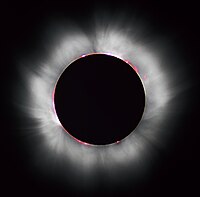
Photo from wikipedia
Obtaining reliable measurements of plasma parameters in the Sun’s corona remains an important challenge for solar physics. We previously presented a method for producing maps of electron temperature and speed… Click to show full abstract
Obtaining reliable measurements of plasma parameters in the Sun’s corona remains an important challenge for solar physics. We previously presented a method for producing maps of electron temperature and speed of the solar corona using K-corona brightness measurements made through four color filters in visible light, which were tested for their accuracies using models of a structured, yet steady corona. In this article we test the same technique using a coronal model of the Bastille Day (14 July 2000) coronal mass ejection, which also contains quiet areas and streamers. We use the coronal electron density, temperature, and flow speed contained in the model to determine two K-coronal brightness ratios at (410.3, 390.0 nm) and (423.3, 398.7 nm) along more than 4000 lines of sight. Now assuming that for real observations, the only information we have for each line of sight are these two K-coronal brightness ratios, we use a spherically symmetric model of the corona that contains no structures to interpret these two ratios for electron temperature and speed. We then compare the interpreted (or measured) values for each line of sight with the true values from the model at the plane of the sky for that same line of sight to determine the magnitude of the errors. We show that the measured values closely match the true values in quiet areas. However, in locations of coronal structures, the measured values are predictably underestimated or overestimated compared to the true values, but can nevertheless be used to determine the positions of the structures with respect to the plane of the sky, in front or behind. Based on our results, we propose that future white-light coronagraphs be equipped to image the corona using four color filters in order to routinely create coronal maps of electron density, temperature, and flow speed.
Journal Title: Solar Physics
Year Published: 2018
Link to full text (if available)
Share on Social Media: Sign Up to like & get
recommendations!